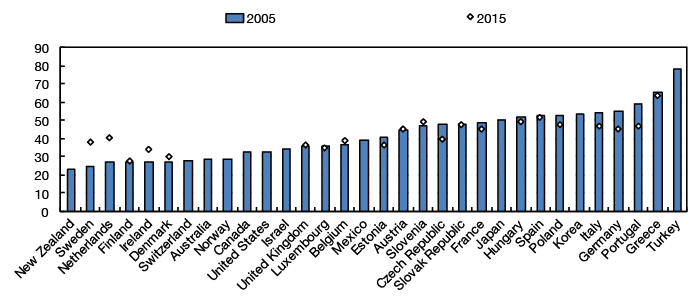A typical employee in an OECD country spends between 32 and 40 hours a week, and an increasingly large share of his or her adult life, at work. The quality of their job has an important impact on the overall quality of individuals’ lives and their well-being (Muñoz de Bustillo et al. 2011) and can be an important factor to promote greater aggregate labour force participation, productivity and economic performance (Harter et al. 2002, Oswald et al. 2015). But job quality can be an elusive concept if not grounded in hard data. The OECD has developed a new framework (OECD 2014, 2016) to measure and assess the quality of jobs, which rests on three objective and measurable dimensions to provide a comprehensive assessment:1
- Earnings quality captures the extent to which earnings contribute to workers' well-being in terms of average earnings and their distribution across the workforce (Figure 1). Average earnings provide a key benchmark for assessing whether having a job ensures good living conditions, while the way earnings are distributed across the workforce matters for well-being and economic performance.
- Labour market security captures those aspects of economic security related to the risks of job loss and its economic cost for workers. It is defined by the risks of unemployment and the income support received in case of unemployment (Figure 2).
- Quality of the working environment captures non-economic aspects of job quality and is summarised by the incidence of job strain that can impinge on workers’ health and well-being. Job strain occurs when high demands on workers, such as time pressure or unhealthy working conditions, are combined with low resources available to address them, such as a lack of work autonomy or training (Figure 3).
The results across OECD countries show a great deal of heterogeneity. Differences in earnings quality are primarily driven by gaps in average earnings, with the Netherlands, Luxembourg, and Switzerland at the top of the OECD ranking, and Mexico, Turkey, and Chile at the bottom. However, the way earnings are distributed across the workforce also matters. For instance, the US has about the same level of earnings quality as Ireland in spite of higher average earnings, because of the much higher earnings inequality. Differences in labour market security are mainly driven by the risk of falling into unemployment, with Greece and Spain standing out, but effective compensation systems are key to limiting unemployment’s negative effect on income. Finally, differences in the quality of the working environment are driven by the ability of countries to combine highly demanding jobs with adequate resources to fulfil the required tasks.
Considering the three dimensions together, job quality is the highest in the Scandinavian countries, Australia, Austria, Germany, Luxemburg, and Switzerland. At the other extreme, relatively low job quality is found in Eastern and Mediterranean countries.
Figure 1 Earnings quality
(PPP-adjusted gross hourly earnings in US dollars, 2013 or latest year available)
Source: OECD Job Quality Database (2016).
Figure 2 Labour market insecurity
(risk of becoming unemployed and its expected cost as a percentage of previous earnings, 2013)
Source: OECD Job Quality Database (2016).
Figure 3 Quality of working environment
(incidence of job strain, %)
Source: OECD Job Quality Database (2016), based on the 6th European Working Conditions Survey (forthcoming) for 2015 and International Social Survey Progam Work Orientations Module III for 2005.
Results also show considerable variation in job quality across socioeconomic groups. The worst off are young, low-skilled workers. Not only do they have the poorest performance in terms of employment and unemployment rates, but they also have the worst outcomes with respect to job quality: lower earnings quality, considerably higher labour market insecurity and higher job strain (especially for the low skilled). High-skilled workers, on the contrary, perform well on all dimensions, showing that returns to skills show up not only in the form of higher employment but also of better jobs. Between men and women, the picture is mixed: women suffer from a large gap in earnings quality but labour market security is similar, while men are more likely than women to experience job strain.
The Global Crisis obviously did not improve job quality. Looking at the three dimensions of job quality together and trying to abstract from some inevitable composition effects, only Germany experienced an improvement in all aspects of job quality (on top of an increasing employment rate despite the deep albeit short-lived recession in 2008-09). At the other extreme, Greece experienced both a sharp rise in unemployment and a fall in earnings quality and labour market security (while the incidence of job strain remained stable). In the UK, where employment after the initial dip in the early years of the Crisis is now almost back to pre-Crisis levels, earnings quality decreased over the period but labour market security fell only slightly, while the quality of the working environment was unaffected. In other OECD countries, the effects of the crisis were much more mixed. In Portugal, for example, earnings quality stagnated and labour market security fell considerably because of the upsurge in unemployment that is still far from being reabsorbed, while quality of the working environment improved for those people still employed. Conversely, in Sweden earnings quality improved but labour market security decreased and the quality of the working environment worsened (albeit from a relatively high level).
Finally, the evidence suggests that policies aimed at improving job quality will not necessarily face a trade off with the objective of also creating more jobs. On the contrary, there are potential synergies: countries that do relatively poorly with respect to job quality tend to have relatively low employment rates and vice versa. The relationship between quantity and quality is more complex in the short term, and especially now in the aftermath of the Global Crisis. While a number of countries have managed to maintain or even improve both the number of jobs and their quality, others hard hit by the Crisis, with major job losses among the low skilled and low paid, have seen some dimensions of job quality also deteriorate (labour market security) but others remaining stable or even improving, resulting at least in part from the fact that the surviving jobs were of better quality in the first place.
Figure 4 Job quality versus job quantity
References
Harter, J, T Hayes, and F Schmidt (2002), “Business-unit-level relationship between employee satisfaction, employee engagement, and business outcomes: A meta-analysis”, Journal of Applied Psychology 87(2), 268–279.
Muñoz de Bustillo, R, E Fernández-Macías, J I Antón and E Fernando (2011), Measuring More Than Money – The Social Economics of Job Quality, Cheltenham: Edward Elgar
OECD (2014), “How good is your job? Measuring and assessing job quality”, Chapter 3 in OECD Employment Outlook 2014.
OECD (2016), “How good is your job? Measuring and assessing job quality”, OECD Brief.
Oswald, A, E Proto and D Sgroi (2015), “Happiness and Productivity”, Journal of Labor Economics 33 (4), 789-822
Endnotes
1 For more data and information http://www.oecd.org/employment/job-quality.htm









